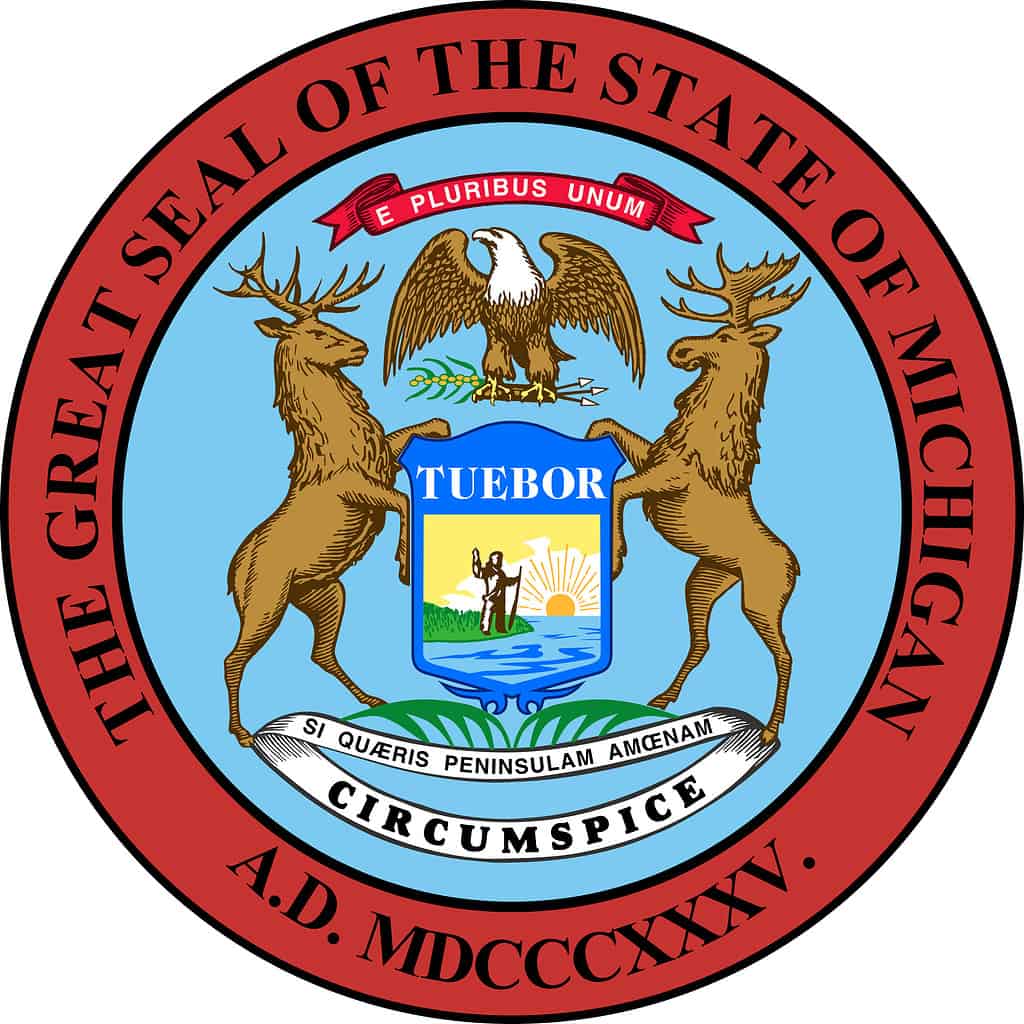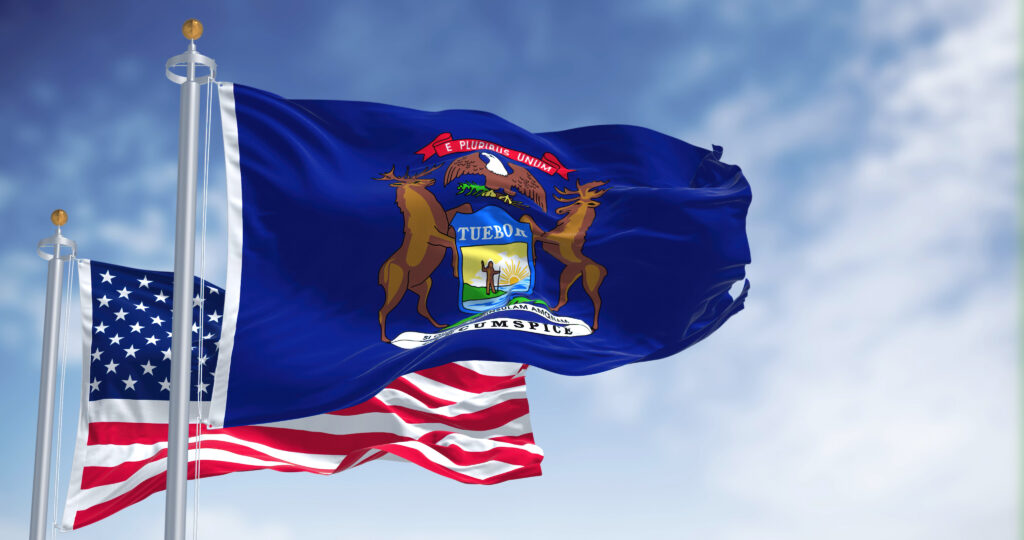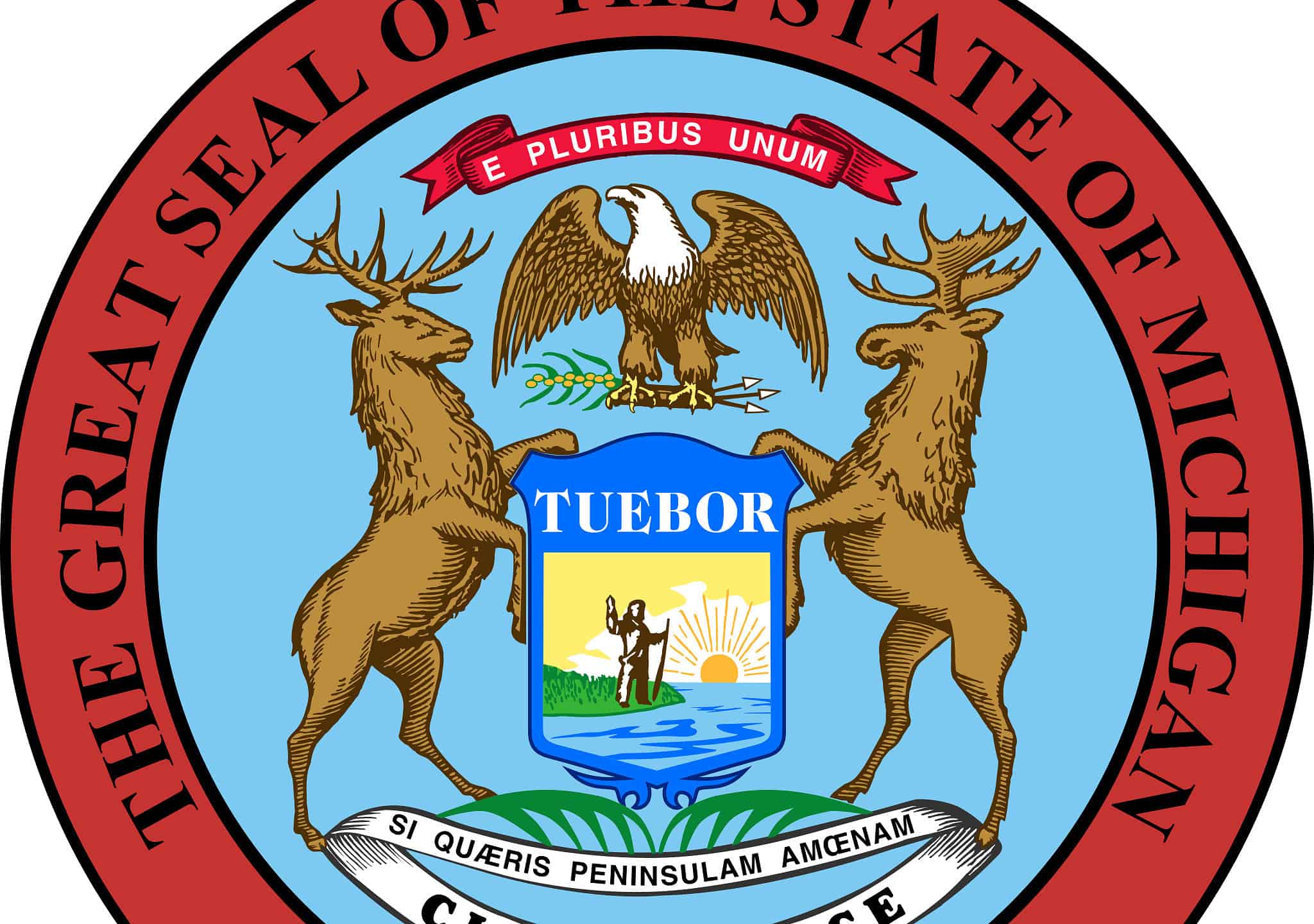The Great Seal of the State of Michigan has a rich history and meaningful design. Its intricacies hold symbolic messages, some of which are not widely known. Here is the history of the official seal of The Great Lakes State, along with the meaningful messages the seal contains.

The Great Seal of the State of Michigan has an intricate, symbolic design.
©Designed by Lewis Cass / Public domain – Original / License
History
Michigan’s official state seal is older than the state itself. Authorities adopted the state seal on June 2, 1835, but Michigan achieved statehood on January 26, 1837.
Lewis Cass, the second governor of the Michigan Territory, designed the seal. Cass modeled the seal after the coat of arms of the Hudson Bay Company. The company was charted in 1670 and still operates today, making it the oldest incorporated joint-stock merchandising company in the English-speaking world.

Michigan’s state seal was modeled after the Hudson Bay Company’s coat of arms.
The Constitutional Convention of 1835 received the seal, the same year Michigan petitioned for statehood. They accepted it and named it “The Great Seal of the State of Michigan.”
However, Michigan’s journey to statehood took longer. Michigan Territory and Ohio both claimed the Toledo strip, a 468-square-mile area between them. This dispute escalated with both sides taking legislative actions, even positioning militias on the Maumee River’s opposing banks. Though only a few shots rang out in the air, this disagreement became known as the Toledo War. The federal government intervened, and Michigan gave the land to Ohio, receiving much of the Upper Peninsula in exchange.
Design and Symbolism
The words “The Great Seal of the State of Michigan” appear across the top half of the seal’s circular outer border with “A.D. MDCCCXXXV” imprinted at the bottom. The Roman numeral signifies the seal’s creation in 1835. When the words in this outer circle are removed, the seal becomes the state’s coat of arms. The coat of arms appears on the Michigan state flag, at least for now. More on that later.
E Pluribus Unum
The Latin phrase E Pluribus Unum appears at the top of the seal. The phrase translates to “Out Of Many, One,” referring to the many states that form one nation.
This Latin phrase is also a national motto for the United States. It appears on The Great Seal of the United States. It also features on the flags of both the U.S. Senate and the House of Representatives. The phrase was imprinted on U.S. currency beginning in 1795. The Coinage Act of 1873 made the inscription a legal requirement on all U.S. coins. Coins are still struck with this phrase today. It also appears on paper currency, imprinted on U.S. one and five-dollar bills.
Other states also use the phrase in their official insignias. Along with Michigan, E Pluribus Unum also appears on the official state seals of New York and Wisconsin. It appears on the flag of North Dakota, as well.

The Great Seal of the United States features the Latin phrase
E Pluribus Unum.
©grebeshkovmaxim/Shutterstock.com
Bald Eagle
The bald eagle, the U.S. national bird, appears below E Pluribus Unum on Michigan’s seal. This symbolizes the authority of the U.S. federal government.
The eagle on the seal clasps symbols in its talons. One foot holds three arrows while the other grasps an olive branch.
The olive branch symbolizes both the state and the nation’s desire for peace. The olive branch bears 13 olives, representing the original 13 U.S. colonies. This detail is sometimes lost in artist renderings of the seal.
The eagle is facing toward the olive branch, representing the strong preference for peace. However, the arrows in the grasp of the eagle’s other foot indicate that both Michigan and the United States as a whole stand ready to defend its people, principles, and interests.

The bald eagle is the U.S. national bird and features prominently on Michigan’s state seal.
©iStock.com/emranashraf
Shield
A shield appears in the center of Michigan’s state seal. Shields are not offensive weapons. They are exclusively defensive, which fits with the Latin word Tuebor that appears on the shield. The word translates to, “I will protect you.” This refers to Michigan’s frontier position and the willingness of Michigan to defend its residents and territory.
A Welcome and a Warning
Below the word, Tuebor stands a man on the bank of a waterway. Michigan sits on an international border. The Michigan/Canada border is made up entirely of water, be it the huge expanse of one of the Great Lakes or a smaller river.
As a border state, the man is holding up his right as a sign of peace, welcome, and friendship. His left hand, however, grasps a rifle. This again reiterates the point that Michigan desires peace but will not hesitate to defend itself.

The Ambassador Bridge connects Windsor, Ontario, to Detroit, Michigan.
©Roxana Gonzalez/Shutterstock.com
Elk and Moose
The shield in the center of the state seal is held by two animals, an elk on the left and a moose on the right. Both animals were once found throughout Michigan.
Elk
The native elk in Michigan were extirpated in 1875. Reintroductions in 1918 brought the animal back, albeit in very small numbers. Those few elk grew in number, though. There are between 870 and 1,684 elk in the state today, according to a 2022 aerial survey performed by the Michigan Department of Natural Resources. Many of the state’s elk are found in the Pigeon River Country State Forest.

Michigan’s elk population is small but stable.
©iStock.com/DimitrisTimpilis
Moose
In the nineteenth century, the influx of settlers decimated Michigan’s moose population. By 1890, the Lower Peninsula had lost all its moose, and only a handful remained in the Upper Peninsula. The 1930s saw the beginning of reintroduction efforts in the Upper Peninsula, with moose transfers from Isle Royale to the mainland. Then, in the mid-1980s, more moose, sourced from Algonquin Provincial Park in Ontario, Canada, found a new home in the Upper Peninsula.
Today, the largest concentration of moose in Michigan resides in Marquette, Baraga, and Iron counties. However, you can also spot them in smaller numbers in Alger, Schoolcraft, Luce, and Chippewa counties.

Moose were reintroduced to the Upper Peninsula in the 1930s and again in the 1980s.
©Tom Tietz/Shutterstock.com
Peninsulas
The elk and moose are standing atop another Latin phrase: Si Quaeris Peninsulam Amoenam Circumspice. The phrase translates, “If you seek a pleasant peninsula, look about you.” Lewis Cass created the seal in 1835. However, it wasn’t until 1837, following the Toledo War compromise, that Michigan gained the Upper Peninsula. Initially, the seal’s phrase likely referred just to the Lower Peninsula, but with the addition of the Upper Peninsula, it became even more fitting. Notably, Michigan is the sole U.S. state comprising two peninsulas.
Changes
There were minor changes to the state seal after its creation in 1835, but there have been no changes since 1911.
There have been proposed changes to the state flag, though. As noted above, the current state flag features the coat of arms, which is simply the state seal minus the words in the outer circle.
A Michigan legislator, Rep. Phil Skaggs, D-East Grand Rapids, is out to change that. He refers to the current flag as an “SOB flag,” meaning “seal-on-a-bedsheet.”

One Michigan legislator believes Michigan needs a new state flag.
©iStock.com/rarrarorro
He notes that according to a guide published by the North American Vexillological Foundation entitled “Good” Flag, “Bad” Flag, a good flag has five basic qualities:
- Simplicity
- Use of only a few contrasting colors
- Meaningful symbolism
- No use of lettering or seals
- Distinctiveness from other flags
Skaggs points out that the current state flag violates each of these design principles. He believes the flag’s complexity limits the connection Michigan residents feel toward the flag. The legislator is pushing for a new state flag that will not include elements from the state seal/coat of arms.
Thank you for reading! Have some feedback for us? Contact the AZ Animals editorial team.








